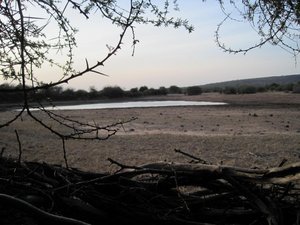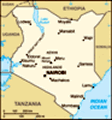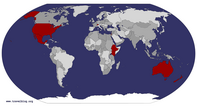Advertisement
Published: July 11th 2009

 watering hole
watering hole
View from behind the blind that Zach sits in every chill morningLast week
I finished my field work the previous week and so this week mainly consisted of me entering data for Truman (he did pay for this trip after all!) and piggy-backing on other people’s projects. On Monday, I went with one of the Princeton undergrads, Zach, to the watering hole near MuKenya. His project involves categorizing plains zebra reactions to different types of dung (actually pellets with sterilized poop smell, lion and zebra) when they approach a major resource, water. We sat in a rough blind and I worked the little digital movie camera while he took notes. I lost feeling in my hands (it’s damn cold now at night and in the mornings) but I witnessed strong zebra reactions to the lion-dung scented pellets. One herd actually ran away and would only come back to the watering hole after another herd entered through an area that was not lined with lion dung. The male zebras stood watch, their legs firmly planted, their round bellies hanging low, a mixture of vividly-colored beauty and amusing rotundity, while their harems drank. Five jackals stole in later, moving like coyotes in their near-timidity and light trotting. I watched the African spoonbill wading

 standing guard
standing guard
The male plains zebra watching out for his haremin the water and tried to ID the various sparrow-esque birds flitting about.
Tuesday afternoon I went out with Stefan, grad, and Wesley, undergrad. Stefan studies behavioral responses of Grevy’s gazelle to different alarm noises, zebra, leopard, and chain saw. The chain saw is a danger-noise “control.” His work bounced us all over the roads in the southern end of Mpala Ranch as we searched for gazelles. Johnny Cash followed by Led Zeppelin blared out tinnily from the playback speakers he has for his research. When they saw a gazelle or a herd, Stefan would slowly walk nearer toward them and then signal Wesley to play the sounds. Stefan would note how long the gazelle would monitor (stand at wary attention and not graze) in response to the noise. I found it highly amusing when Stefan saw a young gazelle defecate and cried out, “Juvenile poop! I gotta get that!” I love being and hanging out with ecologists. We’re so frickin’ weird.
Wednesday morning took me up into the air. I had managed to ask Kayna, the field tech for Rosie Woodruffe’s wild dog project, at the right time for the privilege of going up with her on

 the plane
the plane
What Kayna goes up in every week to radio-track wild dogsone of the plane-tracking mornings. Several dogs within each pack have been collared over the past three years and once a week, Kayna goes up with a pilot to see where the packs and/or individuals are. Then once she gets back down, she hops in her vehicle and goes in pursuit of them. I’m not sure what data she takes when she sees the pack. The plane was a little four-seater, remarkably clean and new looking on the inside. The pilot was a Kenyan with the pink, heavily weathered skin so many white Kenyans have around this area. White Kenyans age fast in the wildlands. Too much sun and wind, I suppose. I sat back and enjoyed the scenery while the beeping of the collars filled my headset. The land alternated between flat-as-a-board and ragged mountains shoving up out of the earth, sometimes singly, occasionally in a small range. The labyrinthine river systems resembles inverted scar-tissue carved into the landscape . Erosion is a major force in this part of the country. Once the tracking was done, the pilot took us low, playing Alanis Morissette, and we made out the individual figures of herders moving their animals to water and

 total pro
total pro
I could totally be a pilotthe multiple boma sites, round rings of acacia bushes that herders use to enclose their herds at night. Each boma site is used for two to five years and the dung gets to be a meter high. You know a herder by the fact that when flies settle on his face, he doesn’t flinch or brush them off. We scared a herd of eland, lumpy and whitish, and roused a huge, lone male buffalo, dark as shadow.
Thursday I played in mud for Renee’s sake. I was helping her plant grasses in black plastic bags. That night we had a movie night in the library meeting room and projected Spiderman onto the wall. About thirty or so people showed up even though, we found out later, almost all the Kenyans had watched Spiderman before in that meeting room. And Friday, I finished data entry and dived back into Nanyuki madness, pulling Renee and Janet with me. I got thoroughly Nanyukied and was jittery for a solid hour after we got back. However, I purchased snacks for the trip (Digestives and Cadbury chocolate), found gifts I wanted for loved ones, and found things I never knew I wanted. I have

 river scars
river scars
Erosion is a major player in this landscapea hard, hard time resisting jewelry that is brightly colored, beaded and so alluringly inexpensive. And today, my last full day at Mpala, I said good-bye to the incorrigible, hilarious Renee and Janet and the outgoing Swedish-American Stefan (they left for a Mt. Kenya hiking trip today) and all the field assistants I’ve come to know. Lauren, who arrived on Thursday, then gave me no time for moping and whisked me and her parents away to Ol Pejeta Conservancy where she has her sites. She works with edge interactions of bomas. Don’t be fooled by the title “conservancy;” it has nothing to do with non-profits. It just means that wildlife is not run off or shot at. I did NOT get to see the black rhinos that rampage around Ol Pejeta but what was really intriguing was the array of wildlife that were so easily visible and out in the open. Admittedly, there is more open on Ol Pejeta since there are many more plains areas where acacias don’t obstruct the wildlife viewing which makes it ideal for tourism, the ranch’s major source of income after cattle. I saw my adored warthogs by the dozen, red-gold hartebeest, Thompson’s gazelles with

 bomas
bomas
Very cool to look at from up above and very neat to study (their after-effects on the vegetation and wildlife) on the groundtheir madly flicking tails, and plains zebra that merely trotted, not sprinted, away from the car. Ol Pejeta has different dominant plants that are naturally greener and bushier, giving it a less stark, less inhospitable aspect than Mpala has. And that greater openness and flatness widens the feel of the place.
And tomorrow Lauren, her parents and I are off on safari! Aberdares, Kakamega Forest, Masai Mara, and then Lamu. Can’t decide which I’m most excited about so I’m just giddy about them all!
End of the season musings
My first summer here at Mpala, now two years ago, had a much different flavor to it. I was going to start graduate school in the fall which meant facing the prospect of living very far away from family and friends in Texas, I was getting to know Truman, my advisor, and my labmates, I was trying to figure out what I wanted to do for my dissertation, exploring ideas for both Kenya and for the US, and it was my first time in Africa. I had a lot on my mind. I enjoyed my experience here, constantly amazed at the wildlife and the habitat, but I do

 las mujeres
las mujeres
Two of my favorite people at Mpala: Janet and Renee. (Mt. Kenya was supposed to be in the background but it was being coy and hid behind its cloud veil.)not think I ever really relaxed, body and soul.
This summer felt different from the get-go. The second day I was here, Renee, whom I had just met, remarked that I seemed remarkably ready and collected for just having got to Kenya. I was able to hit the ground running with my research and feel like I knew the place and many of the people. What has made this summer especially full and good has been the people here. There’s an especially social bunch of researchers this summer, and almost all, foreign and Kenyan, male and female, are outgoing and pleasant, ready for almost anything and willing to share. Because of my own less cluttered state of mind, I have also felt more chatty and sociable than I did before, and it has positively affected my interactions with all the people here. I will miss many of the people here, which I did not totally expect to do in just one month.
And Mpala itself is changing, socially at least. Up until the last two years, there were actual rules about inviting staff (read: field assistants, not office staff) to get-togethers involving alcohol. Which effectively barred field assistants

 hartebeest
hartebeest
On Ol Pejeta. Red-gold coat with horsey faces.from the majority of social events that researchers would throw. As far as I and others can tell, those rules stemmed mainly from barely concealed, dressed-up colonial prejudices and attitudes (with some legitimate boss-employee interaction and general safety concerns). These sentiments were not just held by white Kenyans but also by native Kenyans in upper-management positions around the Centre so it seems to me to be race and class prejudice mixed in with power trips. Banning alcohol at research stations is fine in my book if it’s consistent. However, I cannot believe that making rules regarding alcohol and staff was nothing more than a ruse. There were and are no rules regarding alcohol and researchers, foreign or Kenyan, resident or not, young or old. Suffice it to say, when I was here before, field assistants, cooks, cleaning ladies, etc. were rarely (if ever?) invited to social events, period.
This summer, I feel/hope there has been a sea-change. And that is due to the combination of a handful of super-social grad students who never worked under the old vanguard and some outgoing field assistants ready for change added to the fact that the director of Mpala has changed since I

 warthogs out in the open!
warthogs out in the open!
There were warthogs everywhere! Just for that, I give Ol Pejeta two thumbs upwas last here. According to several of the field assistants that Janet, Renee and I have talked to, this summer has been the first one where they and the other lower-level staff have been actively sought out and invited to parties and social events. I had hoped these perceived inequalities and tensions were all in my head from my first visit here, but not after talking this summer to several of the guys willing and ready to share their views of the social scene. Not to mention I was a witness to some of the ongoing stupid shenanigans and whispered rumors. The facilities manager told me that there are rules prohibiting the mixture of field assistants and alcohol at night, one of the office staff, who is NOT in charge of field assistants, actually drove down to the River Camp to “observe” the 4th of July party (I’m not kidding: he stood outside his car for ten minutes, chatted to a few researchers, and then got back in and drove away), the kitchen staff was ordered by said office person to get back to work despite dinner being four hours away, and some of the post-docs who have been here

 bushbuck
bushbuck
Hands down the most squeezable ungulate in the Central highlands. They're just so shaggy and stuffed-animalish. for several years warned me about sticky issues involving large get-togethers. But now we have definitive information from the director of the Centre that there are NO rules barring any type of social activity. That needs to be made clearer to the upper-level staff and the researchers who worked here during the old regime!
I know there are some legitimate work issues that are at play in all this, complicating matters somewhat. Partying with your boss is always a tricky situation, but we’ve avoided awkwardness since few of the PI’s (principal investigators, mainly professors) or upper-level management staff come out for very long to the parties. Safety is always a concern here in the wilderness, but as Gilbert put it, “Our main job is to keep all of you safe in the field. Why would we do things to risk you at night?” As far as we can tell, those are really just side-issues compared to the underlying colonial and class problems.
Many of these changes are subtle and do not affect the hourly routine of research life, but those changes have completely altered the feel of my time here. Socializing at night and chatting during the

 Ol Pejeta Conservancy
Ol Pejeta Conservancy
One of the many plains that are ideal for wildlife viewingday before work with not just the guys who work for Truman but also with many of the other Kenyans living and working here has really changed my Mpala experience. I can’t say I’m buddy-buddy with any of them yet but I feel much more at ease than I did before. A major part of that is my own steadier self, so different than I was two years ago. Getting to know people from a 180-degrees different culture is always difficult. Getting to know them with unjust rules and hushed-up social wariness hanging over is even worse. Not only was I a happy participant in the first real Mpala dance party, I was also here for the summer of social change. Not bad at all! J
Animal sightings
African spoonbill
Black-bellied bustard
Yellow-necked spurfowl
Speckle-fronted weaver
Steinbuck
African paradise flycatcher
Water buffalo
Sacred ibis
Grey heron
Nutria (noooooo!)
Yellow-billed duck
Blacksmith plover
Advertisement
Tot: 0.077s; Tpl: 0.012s; cc: 7; qc: 24; dbt: 0.0339s; 1; m:domysql w:travelblog (10.17.0.13); sld: 1;
; mem: 1.1mb











